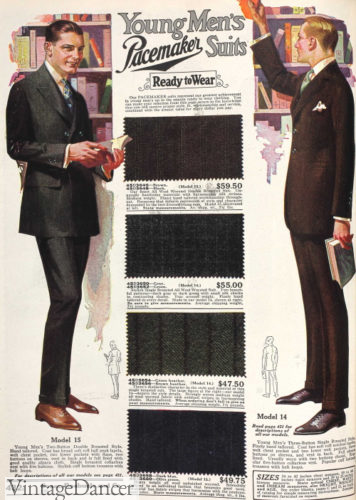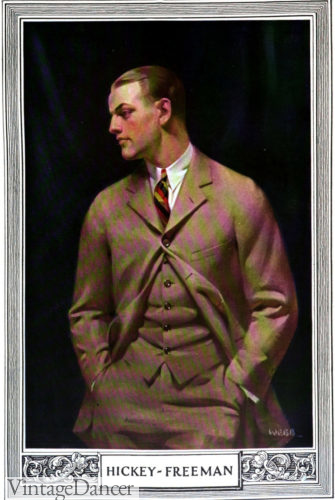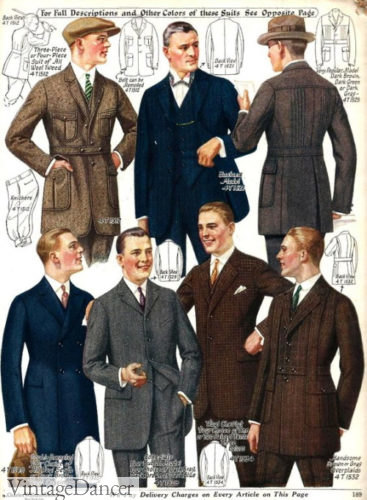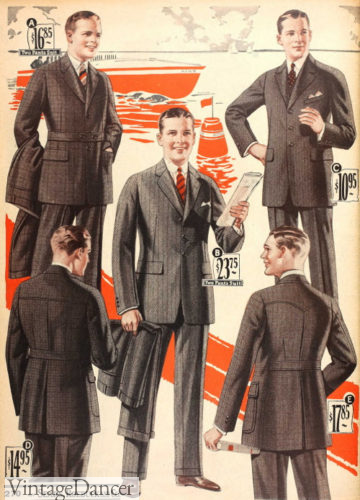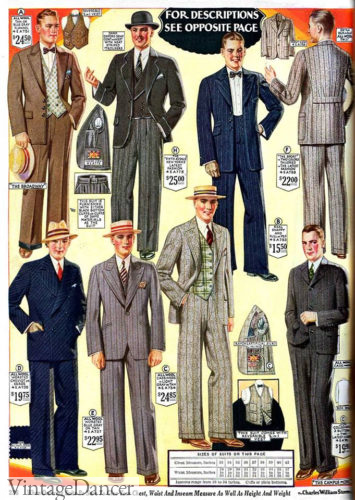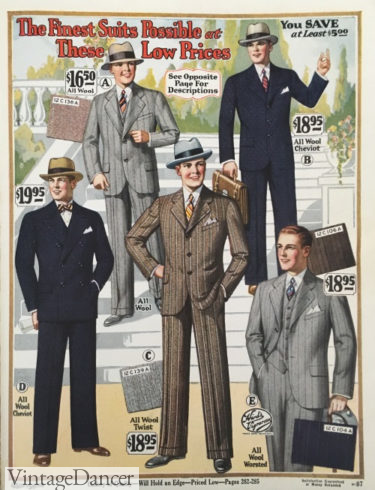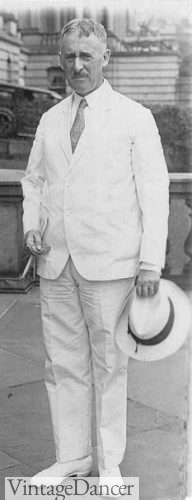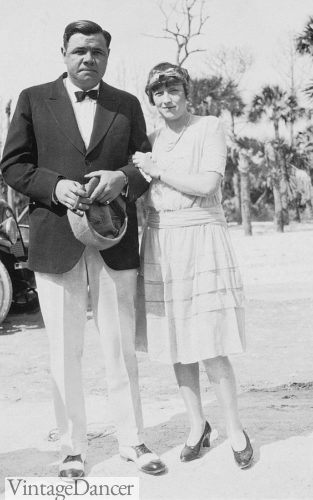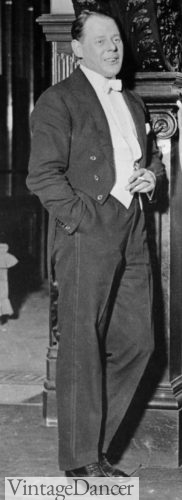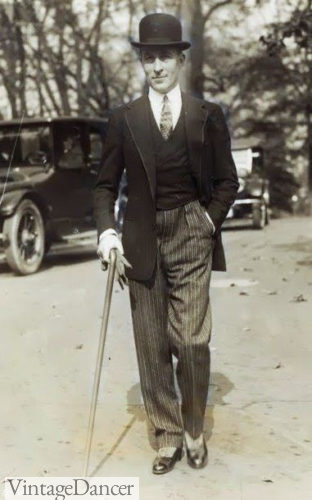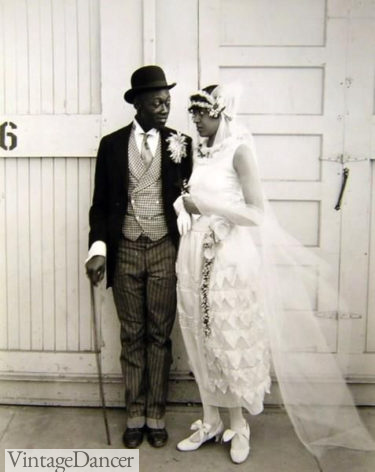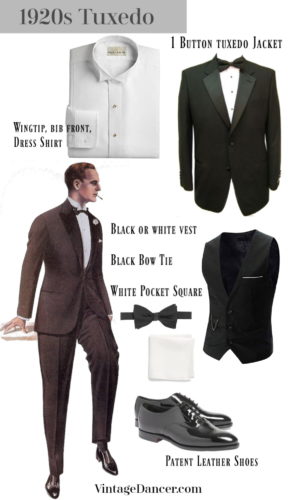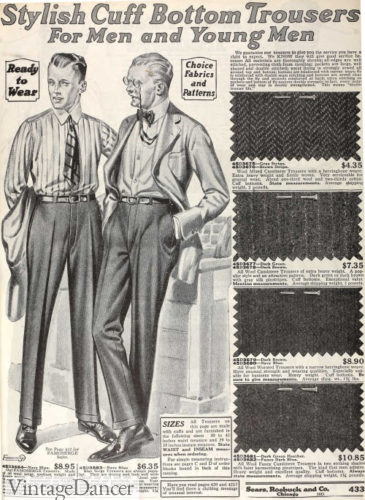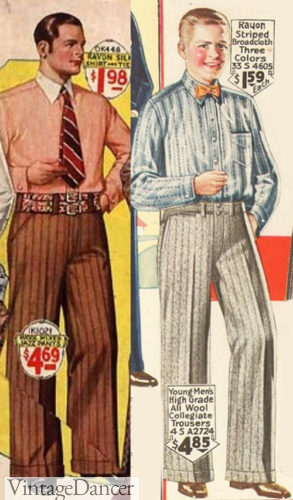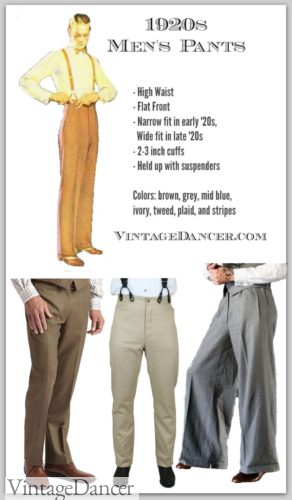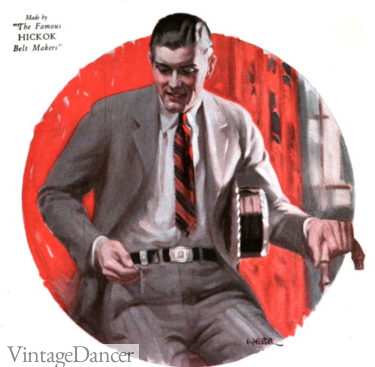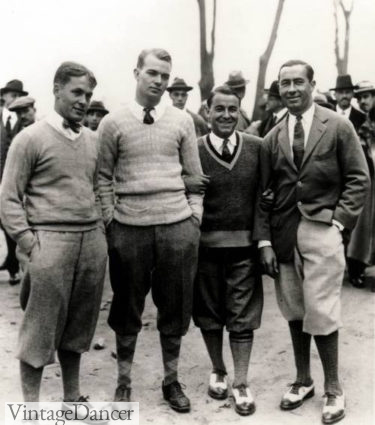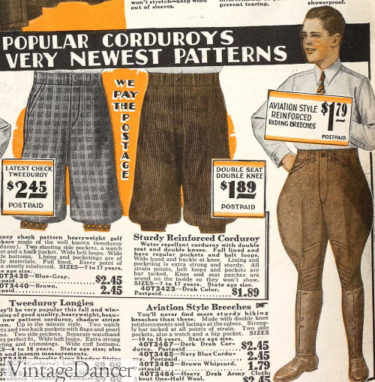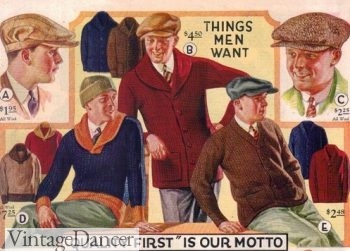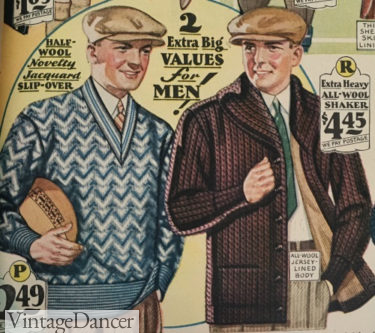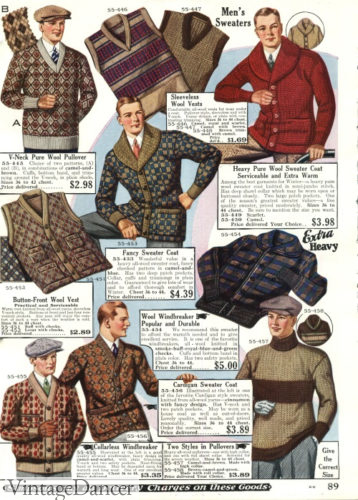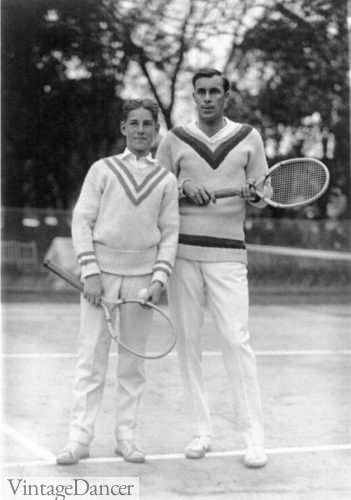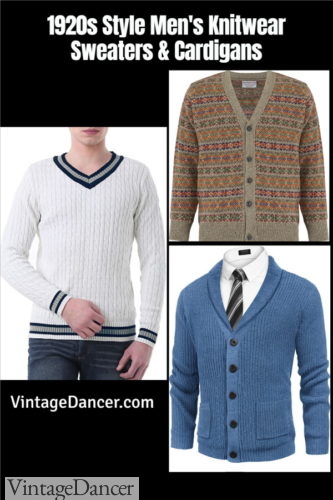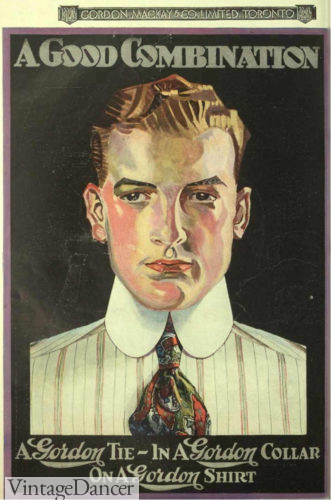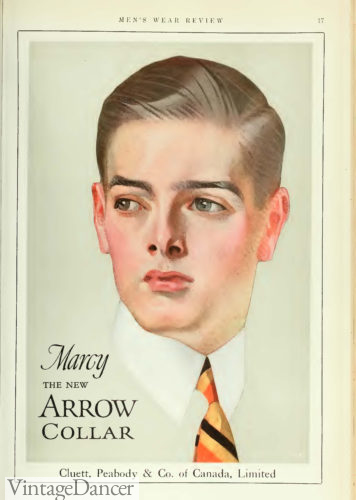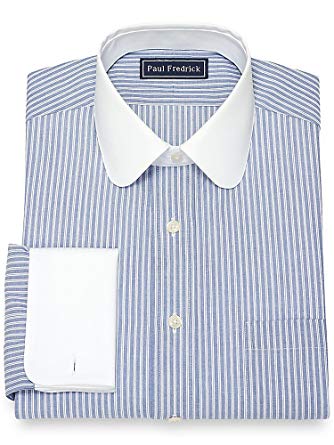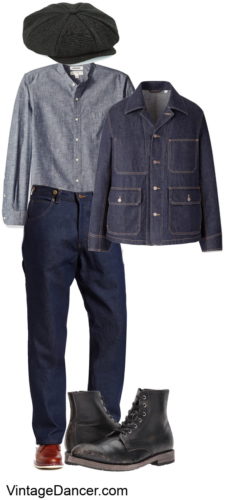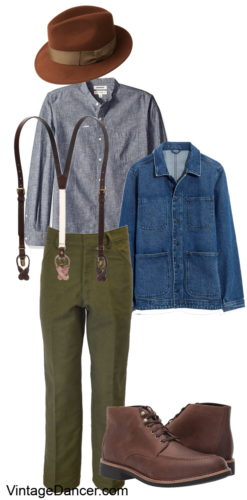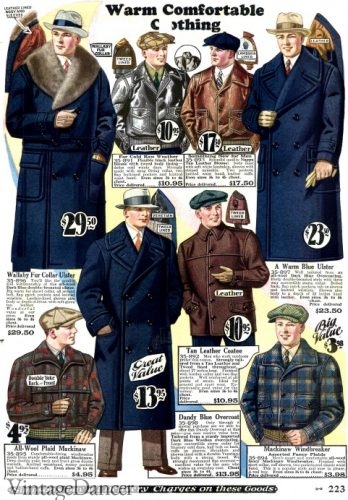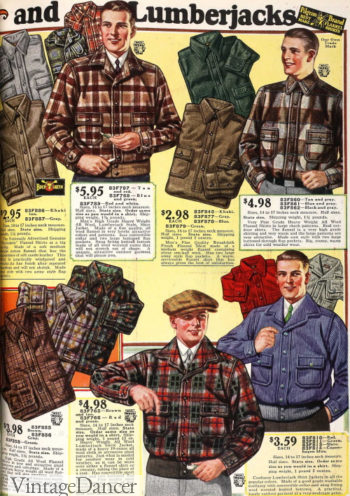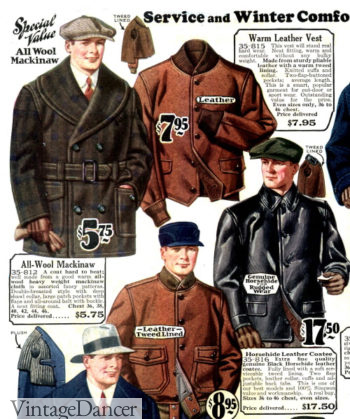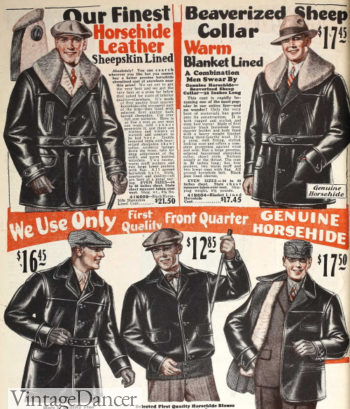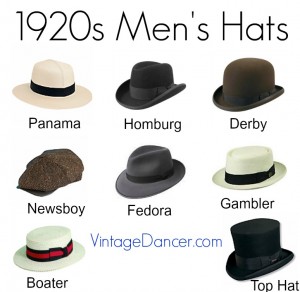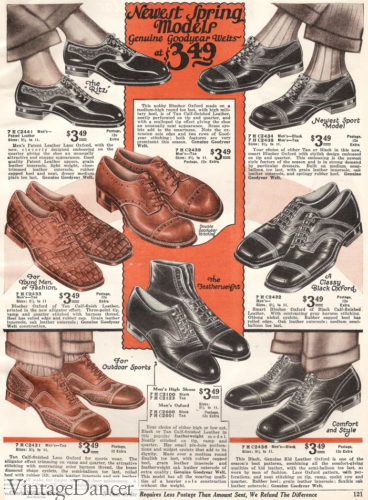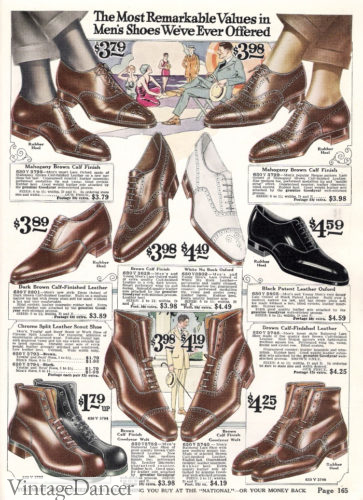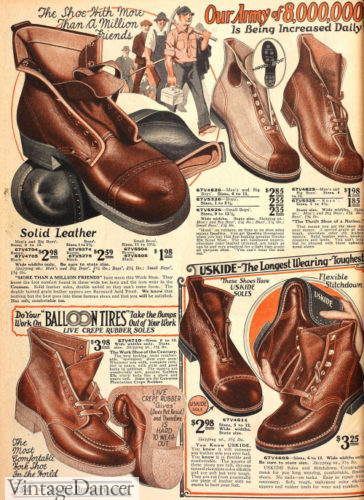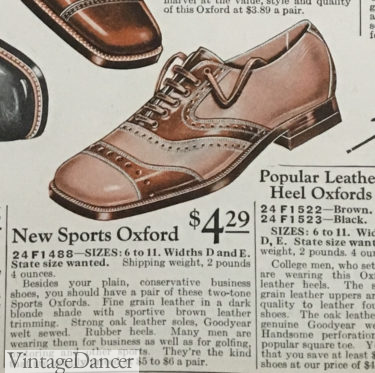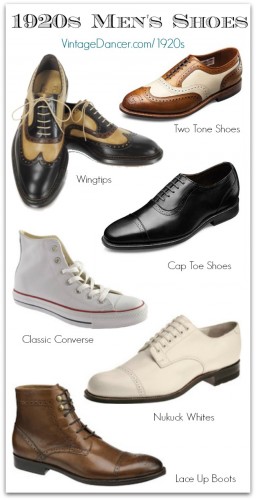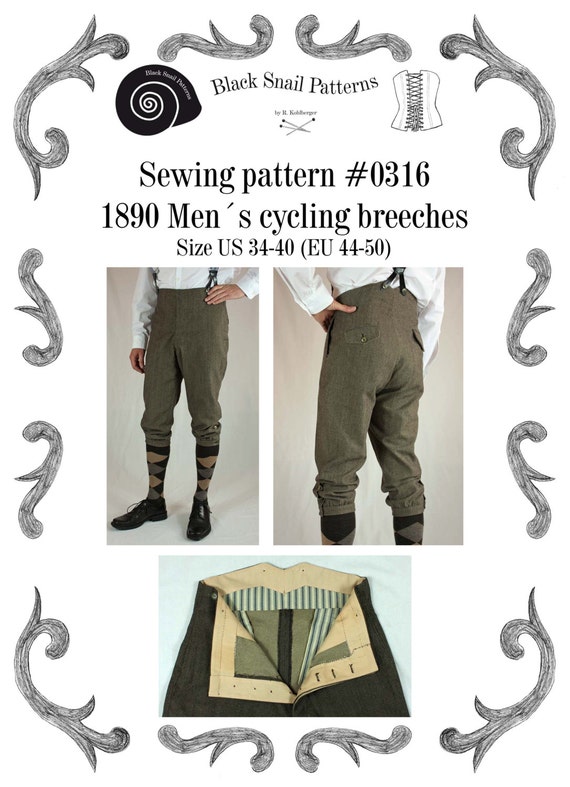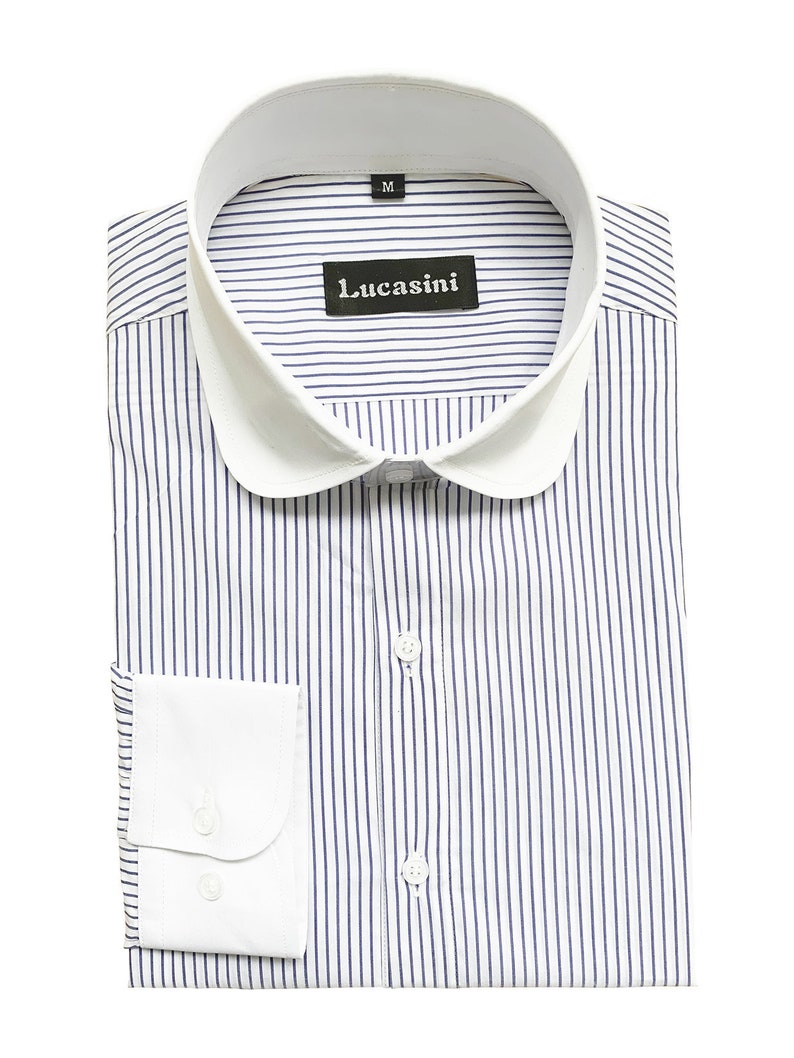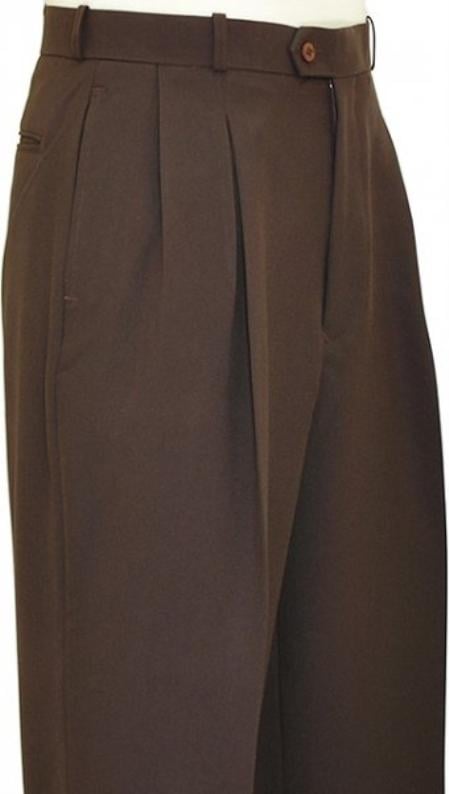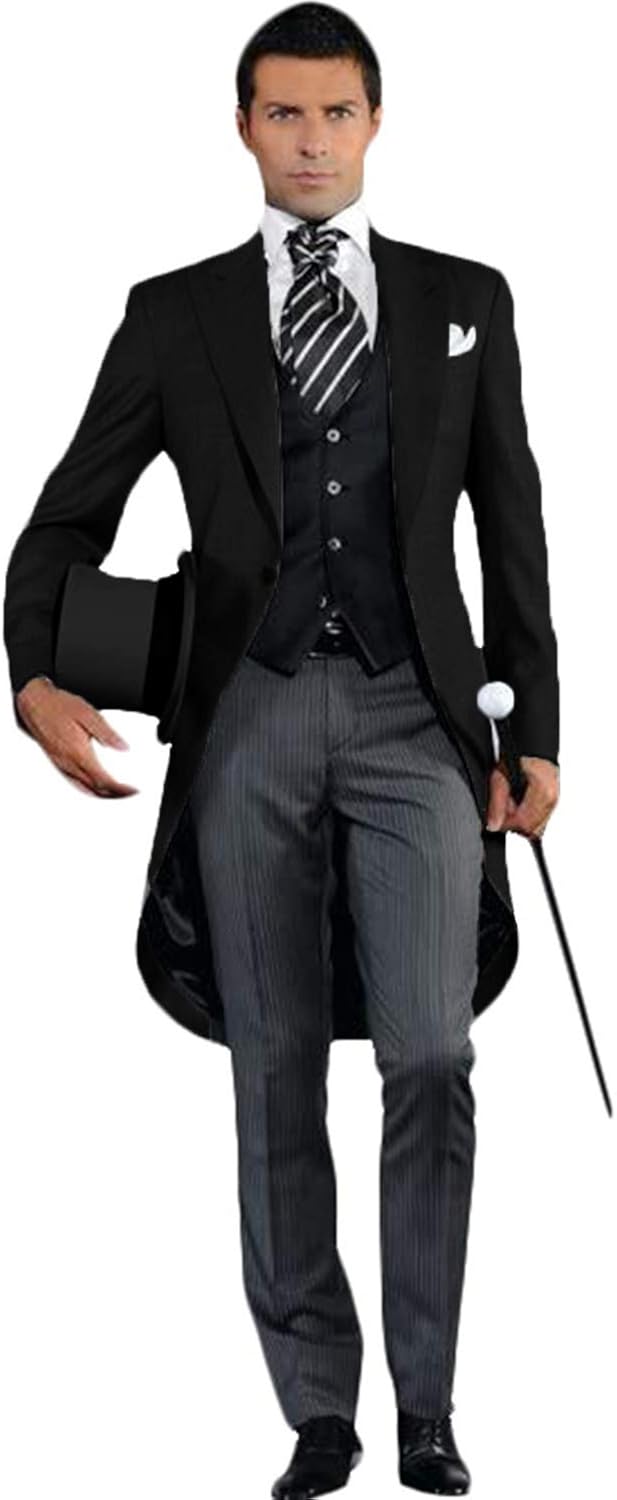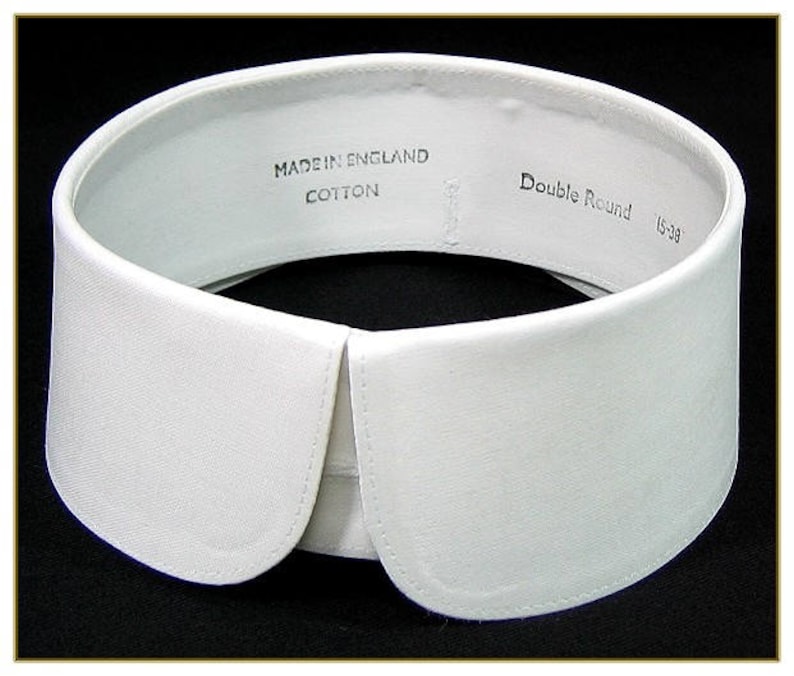1920s men’s fashion was the start of menswear as we know it today. It was a time of classic sophistication with a level of fun that had gone by the wayside in favor of more and more casual modern clothing. Colors in 1920s men’s clothes were mostly neutral with patterns, but the accessories popped with vibrant colors — just like they did for women’s 1920s fashion.
What did men wear in the 1920’s? Popular TV shows such as Peaky Blinders, Boardwalk Empire, and Downton Abbey have brought back the appeal for 1920s men’s fashion today.
There is an extensive amount of detailed 1920s men’s fashion history articles on this website as well as links to new 1920s vintage inspired clothing to create your own outfit for a 1920s party. Here is a brief rundown of 1920s men’s fashion history with links to more 1920s men’s fashion history and shopping sources.
1920s Fashion for Men
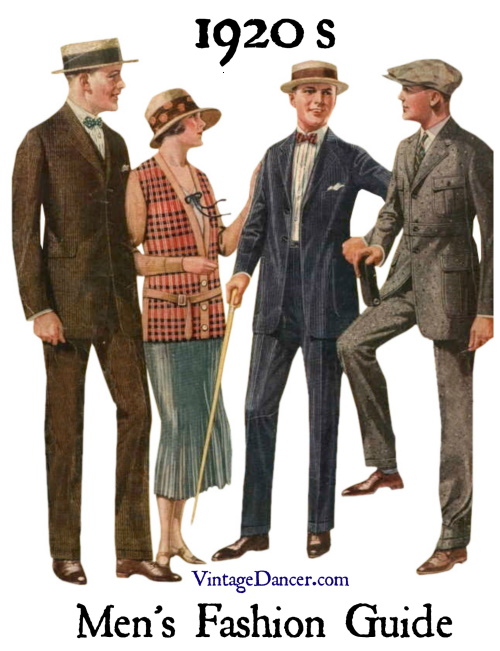
1920s Men’s Fashion Guide
Buy 1920s Men’s Clothing Essentials
- Suits: Three-piece suits with wide lapels and high rise cuffed trousers in stripes, plaid, tweed, and wool suiting.
- Shirts: Narrow stripe dress shirts with white or matching collars. Colored or plaid two pocket work shirts.
- Pants and Breeches – Long pants, work overalls and golf knickers.
- Coats: Long overcoats with wide lapels or shorter plaid mackinaw jackets.
- Sweaters: Pullover, shawl collar, cardigan knit sweaters, and sweater vests for casual outfits.
- Vests and Sweater Vests– Woven or knit vests for layering or worn alone
- Hats: Derby, Homburg, Fedora, Boater, Panama, and Newsboys (Peaky Blinders!) caps.
- Shoes: Cap toe Oxfords, two-tone golf oxfords, lace-up boots and sport sneakers.
- Suspenders: Button on suspenders are very 20s but so were belts with casual trousers.
- Accessories: Neckties or bow ties, pocket watch or wrist watch, collar pin, arm bands, gloves, scarf, spats, cufflinks.
- Workwear and casual clothing for low to middle classes
- Evening suits, wedding clothes- Learn more here.
On to 1920s men’s fashion history:
1920s Men’s Suits
The essential part of a 1920s man’s fashion wardrobe was his suit. For day, evening, work, or parties, a man always wore a suit. The only exceptions were for blue-collar workers, sport players, and young teen and college men who dressed more casually — but even they owned second-hand and often mismatched suits, and wore them with pride.
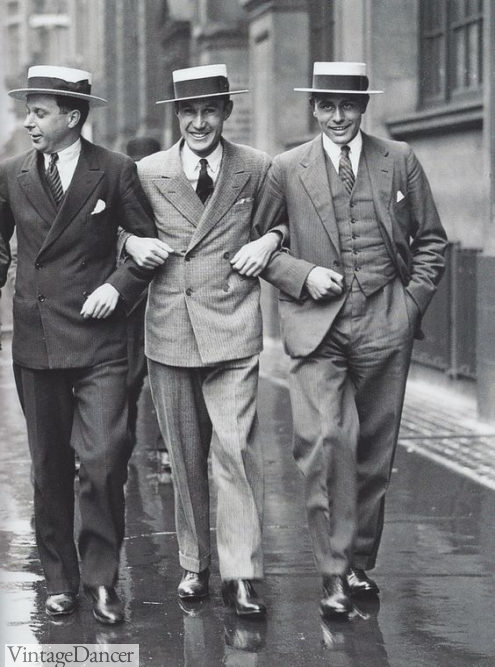
Dapper men in suits and straw boater hats
What sets 1920s men’s suits apart from other decades are the materials and how they fit. Suits were mostly made of thick wool, wool tweed, mohair, wool flannel, and corduroy that made them heavier than today’s suit materials, but lighter than the previous decades.
Suit jackets were either single or double breasted and featured 3 or 4 buttons up the front. The top button came to the center of the heart, giving way to notch lapels that grew wider each year. The height of the suit lapels is what really sets 1920s suits apart from suits of other eras. When buttoned, jackets would completely cover vests, exposing only the shirt collar and necktie.
- 1920 men’s suit fabrics
- 1922 tan suits
- 1923 sport back suits
- 1925 sport back suits for young men
- 1927 colorful suits and vests
- 1928 wide fit suits with stripes
Many 1920s men’s suits featured two sets of flap pockets, which is another characteristic missing from modern suits. The colors, on the other hand, were similar to previous decades: dark and light browns, medium blues, dark green, and greys with the occasional pastel (pink!). There was also ivory, white linen, and cotton seersucker for summer.
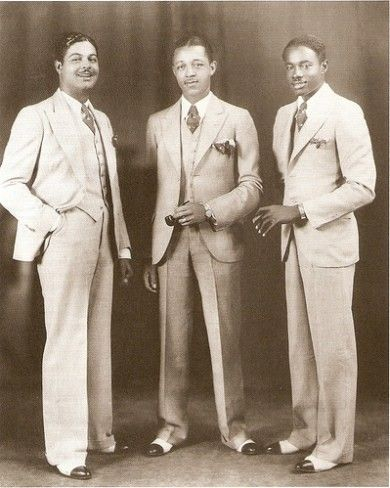
Dapper men in wool summer suits, two tone shoes
- 1929 former Secy. Frank B. Kellogg wears a white suit with panama hat
- Babe Ruth wears a navy blazer and white trousers, two tone oxfords and holds a cap
Patterns were distinctive. They could be big plaids, checks, windowpane, thick shadow stripes, or thin pinstripes. Wearing tweed suits was popular in Europe year-round and for winters in America.
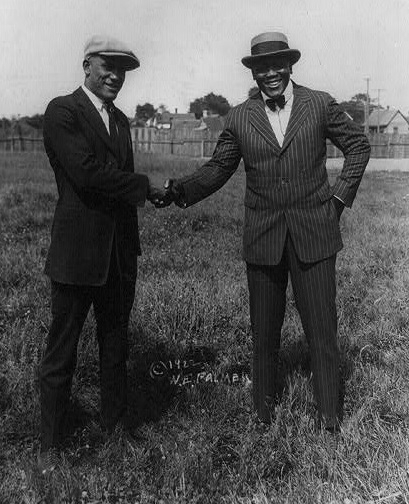
1922 boxer Tut Jackson wearing a striped suit, bow tie and flat top felt hat
Despite what the usual gangster wore in TV and movies, one color a man’s suit was not was solid black. Black was a color for mourning. The 1920s gangster wearing a black pinstripe suit was one perpetuated by Hollywood in the 1940s and 1950s. Wealthy bootleggers and gangsters in the 1920s would have been impeccably dressed in the latest suit fashions, imported from Europe and tailored to a perfect fit. Those devils would have wanted to show off their wealth and have a larger than life image, perhaps to make the gangster life appealing to new recruits.
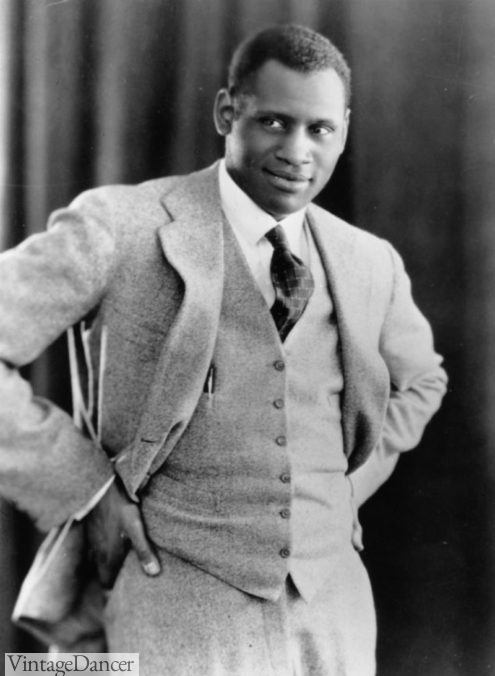
1925 Paul Robeson in a light wool suit with collarless vest
The 1920s suit fit changed from a snug slim fit in the “Jazz age” early years (1918-1923) to a looser boxy fit after 1924. The current trend for vintage-inspired menswear reflects the slimmer fit, while women’s fashion has embraced the later years.
Suit jacket lapels grew wider each year, the peak lapel became a new trend, and the slit pocket became a new feature to suits by the late 1920s. More colors in unique shades such as pink, light green, lilac, blue-grey, and grey-green also emerged in America. Do not be afraid to wear those colors.
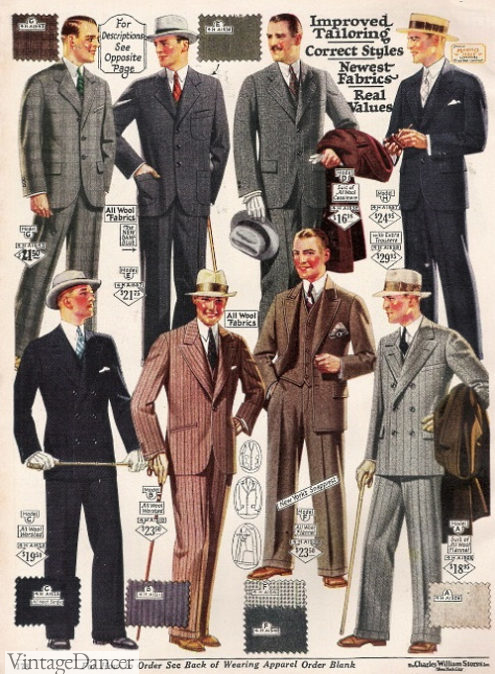
1926 men’s suits (yes that one is pink)
Besides lighter and brighter colors, summer suiting while on vacation or in hot climates embraced the all-white suit. Ivory or bone were easier suit colors to keep clean. White trousers paired with a navy blue blazer was a common summer outfit for yacht owners and ivy league college kids. It was worn with a captain’s hat and either white nubuck Oxfords or two-tone sport Oxfords.
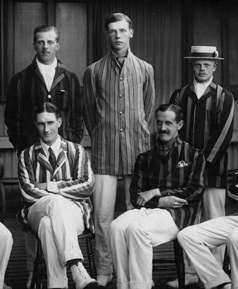
Cricket team wears striped blazers, white trousers, boater hats
Some Ivy League outfits embraced the traditional striped boating jacket made up in a college or gentlemen’s club colors. The rowing team started the look back in the 1860s, but other team sports such as cricket and lacrosse wore them as well. Enthusiastic spectators also began wearing the blazers to sporting events. Find boating jackets here.
The vertical striped blazer or vest may have been adopted by musicians and barbershop quartet singers, but probably not. Again, it was one of those Hollywood (eh-hem, Disney) interpretations that put performers in more colorful costumes. Shop men’s striped vests.
Read more about 1920s men’s suit history.
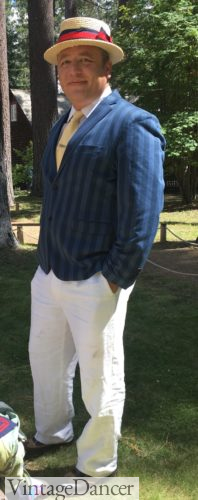
1920s outfit with boating blazer, hat, linen pants
Tips for your 1920s suit: Two and three-piece suits can be found in thrift stores, department clothing stores, and online. Good suits will start at $400 and go up from there. Modern suits are currently favoring a very slim fit however, which is not accurate to the 1920s. Look for a looser, classic fit instead in any neutral color except black for authenticity. Suits with large stripes or plaid or a tweed-like texture will also look more ’20s.
- Authentic: Reproduction 1920s suits can be found, mostly in the UK, for $700 and up. A very worthwhile investment if you want accuracy and quality.
- Moderate: The classic suits in bold patterns from Paul Fredrick double as vintage and modern enough for daily wear. They have good shirts as well. $250 and up
- Budget: Suits imported from Italy have a very ’20s wide fit as well as bold stripes and patterns. MensUSA and MensItaly have a good selection for under $200. Stock levels change frequently so you may not get the exact suit pictured, but something close.
- Modern 20s. The skinny fit tweed suit is a modern vintage take on 20s fashion. Similar to Peaky Blinders suits with a low price.
- Free: Use whatever suit you have and add a vintage hat and accessories. Or leave off the jacket and wear a vest and trousers alone to give yourself a ’20s inspired look.
- Shop these and more men’s 1920s inspired suits here (USA) and here in the UK.
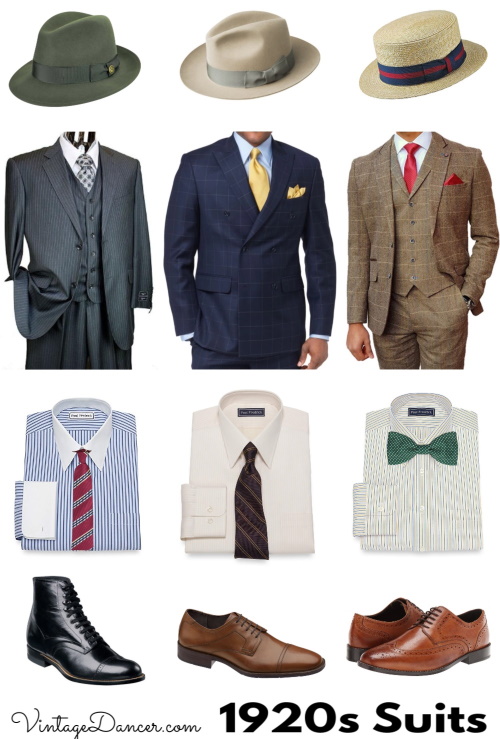
1920s men’s suit, hat, shirt, tie and shoe combinations. Shop suits.
1920s Tuxedos
For evening entertainment, men would change out of a day suit and into a full tuxedo to attend the opera, a fancy dinner, the theater, or a high-end night club. Evening suits consisted of a traditional tailcoat, wide satin stripe dress pants, a white wingtip collar shirt, black silk top hat, black patent shoes, and either a white vest/bowtie for white tie affairs (most formal) or black vest/bow tie for black tie affairs (semi-formal).
The new dinner jacket (tuxedo jacket) began to replace the long tailcoat in the mid-’20s as a more casual and comfortable option.
- 1924 Actor Guy Newell in white tie attire
- Unusual black bow tie and white vest with a tuxedo jacket
The other formal day outfit is the morning suit (not mourning as in funerals). It was worn for weddings that took place in the morning (get it?), as well as classy British events such as Royal Ascots. Some older businessmen continued to wear them to work and gentlemen’s clubs.
A black morning coat paired over grey striped trousers with a buff, ivory or back vest, bowler hat, spats, and a cane. This outfit is experiencing a revival today as a unique groom’s attire. Learn more about 1920s tuxedos and morning suits here.
- Jean Patou, 1924, morning suit
- A wedding in a dapper morning suit
Men’s 1920s Pants or Trousers
Men’s 1920s pants had a flat front or single inverted pleat and a sharp crease down the front of the legs. Pockets were slit on the side and welt on the back with one button closure. Front flys were button-up until the zipper became more common in the later years. The Prince of Wales started the trend for a 2-inch fold up cuff which everyone followed (men followed everything he wore. He was quite a trendsetter!).
- 1920 men’s slender leg trousers with fabrics
- 1927 men’s wide leg trousers
The pant legs were fairly narrow in the first half of the 1920s (the jazz look) and wide by the second half. Collegiate men took these new wide-leg styles to the extreme by wearing “Oxford bags,” which had leg widths of up to 16 inches! They were designed to be worn over knickers, which were banned in classrooms. Mainstream fashions followed, reducing the width down to a comfortable 10-12 inches.
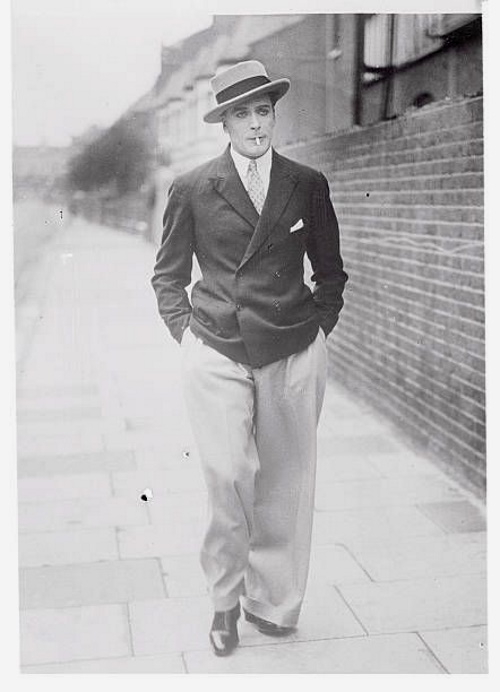
Jack Buchanan 1925 wearing oxford bags
The high rise of the trouser is what makes men’s 1920s pants very different than today’s options. The waistband came up the natural waist (at or above the navel) with a deep seat for ample room. The fit was full around the hips with a tapered leg in the early years and straight, wide leg in the later years.
To keep those high waisted pants up, men used button-on suspenders (clip-on were not invented yet.) They often has wide colorful stripes with an X or Y back. Buy men’s button on suspenders.
A men’s leather belt became more common in the mid 1920s with casual pants and summer suits. A belt was not worn with a suit or vest. Silver or gold belt buckles were often monogramed with initials. Military and western style belt buckles were also common with workwear.
- 1929 suspenders
- 1922 men’s monogrammed buckle belts
What did men wear in the 1920s that is casual?
1920s men’s casual or workwear pants featured even bigger patterns and stripes and more colors than suit trousers. Wool, moleskin, tweed, and corduroy were the primary fabrics in winter. Flannel, light wool, and duck cloth (light canvas) were worn for spring/summer.
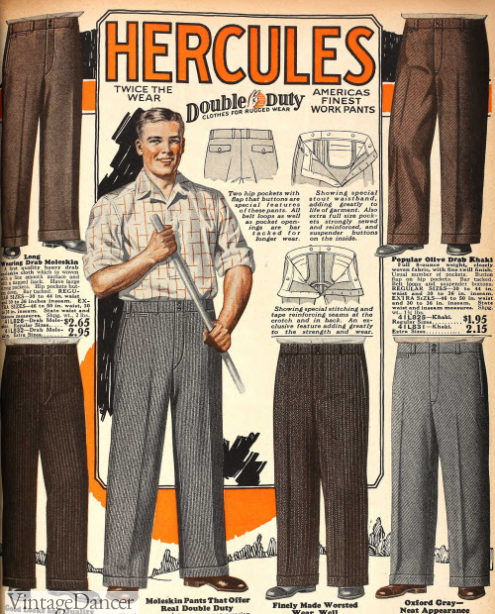
1928 mens work pants
Did men wear jeans in the 1920s? Dark blue denim was used for overalls and heavy-duty work pants. They were not casual everyday men’s clothing for a few more decades. The fit was very wide with a folded up cuff. Learn the history of men’s denim jeans.
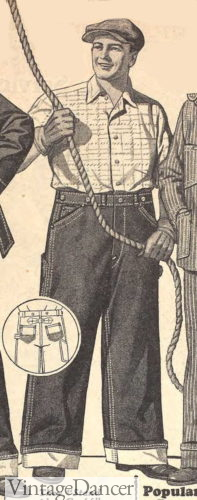
1928 Denim Jeans
For sports such as golf, the knicker pant (also called plus fours) were the preferred summer pant. Boys would wear them instead of trousers until they became men at around 13. Plus four nickers ballooned out around the knee with tall plain or patterned socks to cover the calf. A bold pattern sweater or sweater vest, button-down shirt, tie, or bow tie and newsboy cap completed the casual outfit.
Find 1920s style breeches and golf knickers here.
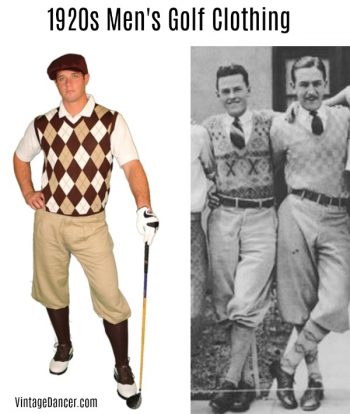
Men’s golfing outfit with shirts, ties, sweater vests, plus fours, tall socks and saddle shoes
- Golf attire wearing plus four pants
- 1929 plus fours and breeches pants
A similar short pant were breeches (jodhpurs) used for hunting, riding, outdoor work, and uniforms for chauffeurs and military men. Breeches laced below the knee to fit inside tall boots or under leather gaiters. The hip was extra wide and roomy- which looks very comical to us now. The seats and inner legs were often double layers of sturdy fabric or suede.
Learn more about 1920s men’s trousers history.
Tips for your pants: Get a pair of high waisted pants and you are half way to a 1920s look. Have a tailor sew on buttons and cuff your trousers for the most accuracy.
- Authentic: A pair of reproduction 1920s trousers will be your best option. Have them hemmed and tailored locally.
- Wide Leg: Wide leg dress pants can be found at MensUSA and MensItaly. They are starting to come into the mainstream but are often pleated at the waist.
- Casual/work: Historical Emporium carries early 20s style trousers with suspender buttons already sewn in.
- Sport: Knickers can be purchased online or made easily by cutting off pants and securing with elastic below the knee.
- Budget: Choose classic fit pants in bold patterns, tweed or linen and pair with suspenders/belt and/or a vest.
- Shop these and more men’s pants and knickers and here in the UK
1920s Men’s Suit Vests or Waistcoats
Unlike today’s two-piece suits, men’s 1920s fashion required a three-piece suit with a matching vest. The poor and lower classes could not always afford a matching vest, so they would wear whatever they could find in a similar shade of color or simply go without. A matching jacket and vest could be mismatched with trousers as well.
Every man dressed as well as he could afford, shopping at second-hand stores, mail order catalogs, or rummaging through church donation bins.
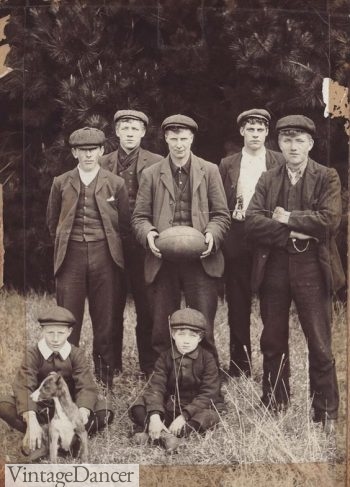
1920s working class men playing football (not Peaky Blinders looking to do gangster things)
Vests, also called waistcoats, had high V-necks, 5-6 buttons, and notch collar lapels. Collarless vests also existed, but I think the collared vest looks and feels more 1920s — especially when worn without a suit jacket. In the late 1920s, the double-breasted or U-shaped shawl vest in matching or contrasting bold prints added variety to young men’s suits.
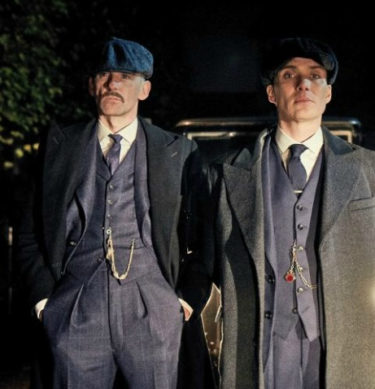
Both collared and collarless vests were worn in Peaky Blinders (Peaky blinders looking to do gangster things!)
An alternative was to wear a pullover sweater vest instead of a suit vest for a casual style. Single color smooth knit or two color cable knit vests as well as vivid patterns of fair isle and argyle made for colorful and sporty outfits. Tennis and cricket players favored the white or ivory sweater or sweater vest with colored trim at the V neck paired with matching white pants.
Learn more about 1920s men’s sweaters and knit vests history.
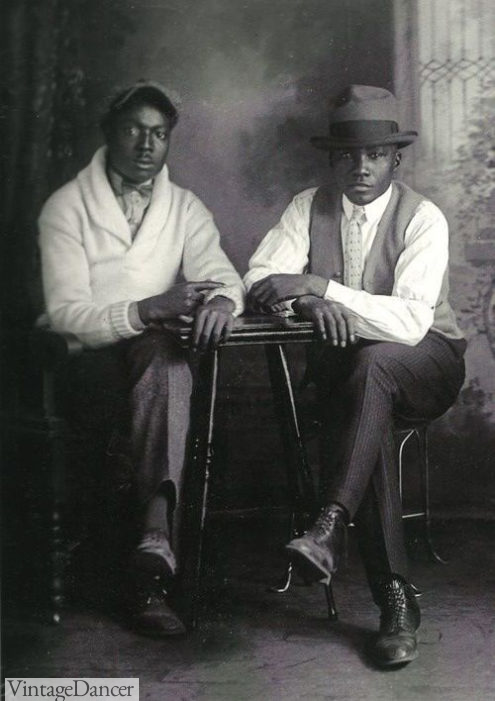
Sweaters, vests, trousers and hats
Tips for your vest: It was a fashion faux pax to have a shirt exposed between the pants and vest. For accuracy, make sure your pants are high enough to fit under the vest. Most modern vests are longer than vintage vests to accommodate mid-rise pants. Suspenders will also help hold up pants higher on the waist. Order pants one size up for an even looser ’20s fit.
Shop men’s 20s vests and sweater vests.

1920s style men’s vests. Shop here.
Casual Sweaters, Knitwear
Knitwear exploded in popularity after WWI. Fashion leaders wore casual, stretchy knit sweaters and cardigans instead of country jackets. Knit was flexible enough to make golfing comfortable and cheap enough to appeal to the lower classes as everyday attire. Sweaters came in saturated colors, textured weaves, and puzzling prints.
As the decade grew on, the colors and patterns went wild — and so did the demand for them. They were worn by all classes, low to high, and for all seasons.
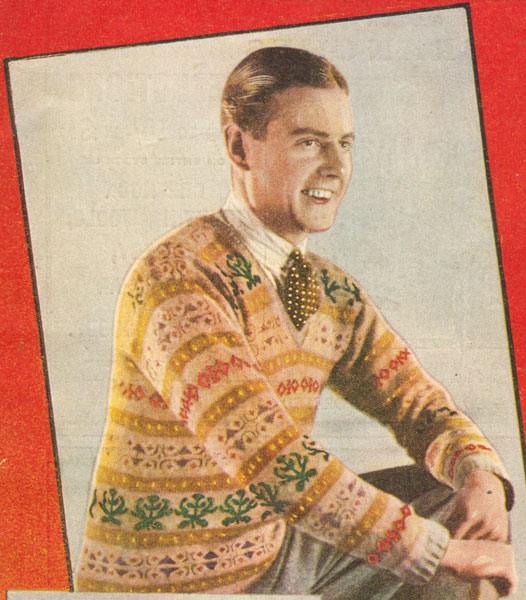
Fair Isle Sweater
Both pullover sweaters and button-down cardigan sweaters featured huge shawl collars knitted in heavy cable stitches. There was also the roll neck sweater, called a turtle neck, which was slim fitting and quite warm. The V neck sweater with wide rib cuffs entered the picture in the mid-20s which was a favorite in spring.
The letter or insignia sweater was a pullover style with a school or team’s initials appliqued on the front. Underneath sweaters men wore dress shirts and neckties in keeping with formality. Learn more about men’s 1920s sweaters and knitwear and men’s sweater vests (pullovers) styles.
- 1920s men’s sweaters and caps
- 1929 V neck chevron sweater and shawl cardigan
- 1928 sweaters , cardigans and vests
- Traditional men’s tennis sweaters with V striped trim. White duck cloth pants and oxford shoes complete the look.
Buy men’s vintage style sweaters, and sweater vests and suits vests.
1920s Men’s Shirts
Underneath suits was where the fun men’s 1920s fashion began (the top part, at least!) 1920s men’s dress shirts were made of colorful vertical stripes in a mixture of colors– tan, green, blue, lilac, sage green, yellow, peach, pink, and white. Solid colors in the white, blue, gray and tan were available in the late 1920s.
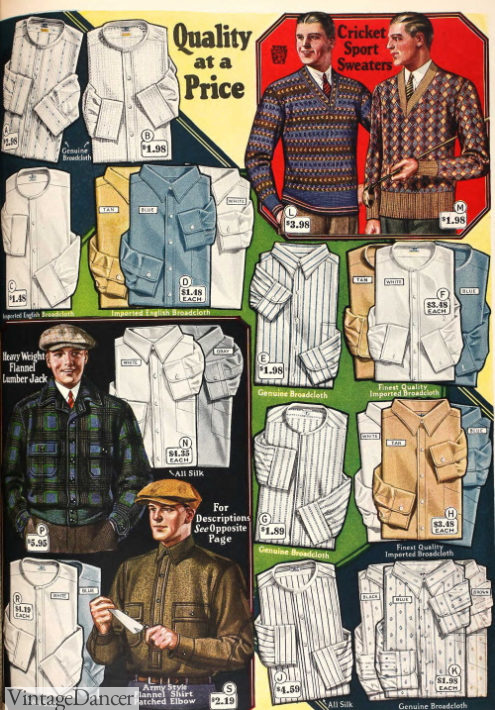
1927 shirts, sweaters and jackets
Shirt collars were round (club collars or penny collars), pointed (2.5-3.5 long) spread (less common), or buttoned down. Most were soft attached collars, but many still came in detachable stiff white linen. Shirts with attached collars were either made with the same material or were white collared.
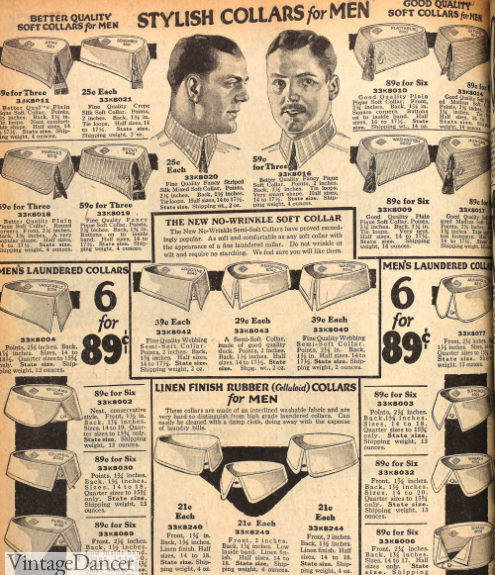
1922 men’s detectable shirt collar – points, round club, spread etc
The white shirt collar against the solid or striped shirt body is what makes early 1920s men’s dress shirts unique.
If you want to make another fashion statement, wear a collarless shirt (also known as a mandarin collar shirt or grandad shirt). The Great Gatsby shocked the fashionable world by wearing a shirt without a collar and then everyone copied him.
Thomas Shelby in Peaky Blinders is also seen without a shirt collar on more than a few occasions. He has the confidence to pull it off. Do you?
Read more about 1920s men’s shirts and collars history.
- Club collar striped shirt
- Straight collar shirt
The cuffs are the final unique dress shirt element. They were usually French, double fold, or button cuffs sometimes worn with a pair of snazzy cuff links. Cuff links were plain gold circles monogrammed with the owner’s initials.
Shirts were sold by neck size only, making the sleeves too long and the body extra wide on many men. Armbands (also called sleeve garters) made of webbing helped keep the sleeve cuffs from sliding down the hands. Shop 1920s armbands.
Shop for men’s 1920s style shirts
Casual men’s shirts and work shirts didn’t look too different than dress shirts except for the attached collars. They also pulled over with 5 buttons spaced down the front instead of the entire shirt buttoning down. They were made of heavy cotton, flannel, wool, or chambray with one or two chest pockets.
Casual and work shirts came in drab solid colors: tan, blue, grey, green but also bold plaids, checks and thin stripes. Most had two chest pockets with a button down flap (not metal snaps). The placement of the chest pockets was half way down the torso, unlike more modern shirts that have pockets about the pectoral muscles.
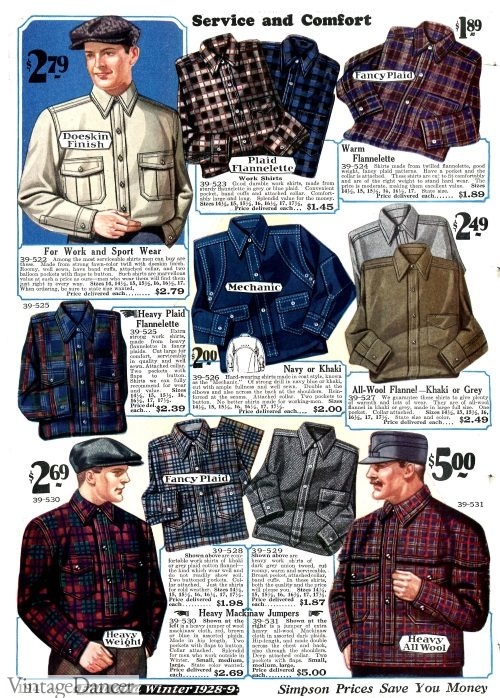
1928 men’s flannel casual and work shirts for winter
Casual shirts were paired with wool trousers, coat, vest (optional) belt/suspenders and a casual hat like the 8-panel cap or cadet cap.
There were no short sleeve shirts in the 1920s with the except of sport uniform shirts. Instead 1920s men would roll up the sleeves of a long sleeve shirt and unbutton the collar.
Underwear in the form of union suits (long johns) look like Henley shirts on the top half, were worn under all men’s clothing. You may have seen some movies show men in casual clothing with only their union suit as a shirt (something real men in the 1920s would never do in public.)
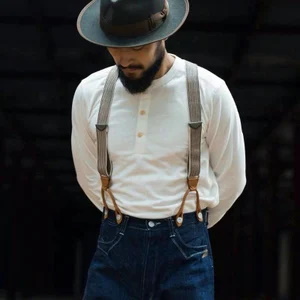
1920s Henley style undershirt by Bronson. Shop shirts and undershirts.
1920s Men’s Workwear/ Casual Clothing
Read about men’s workwear in the 1920s.
- Denim on denim workwear
- Everyday workwear or casaul- chambray shirt, denim chore jackets, wool pants, suspenders, fedora hat, boots
1920s Men’s Overcoats & Jackets
Long heavy wool coats with wide lapels dominated men’s 1920s overcoats. The fur collar coat or wool ulster was favored in winter, while the light trench coat was ideal in rainy climates. College men took to wearing heavy raccoon fur coats.
Shorter jackets such as the plaid mackinaw or leather belted jacket or lumberjack shirt jacket (windbreaker, bomber style) were the ideal working class coats, as well as for the middle class on casual weekends. Read more about 1920s men’s outerwear.
- 1928 mens coats, jackets and hats
- 1926 mens casual jackets
- 1928 Men’s Work or Casual Heavy Jackets
- 1928 men’s black leather jackets
Shop for vintage style men’s coats and jackets.
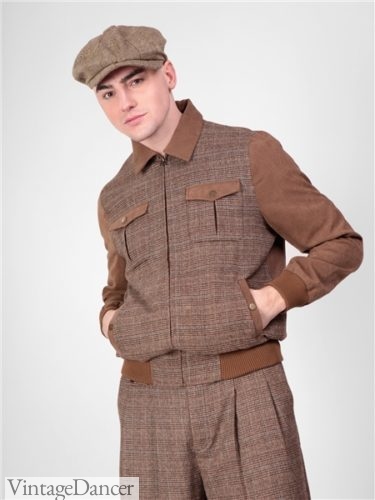
Alister Jacket by Collectif. Shop more vintage style 20s jackets
1920s Men’s Fashion Hats
The 1920s look isn’t quite done. All men, all classes, wore hats… all… the …time. Hats made of felt were worn year-round, but typically were replaced by straw hats in the spring and summer.

Actors Rudolph Valentino, WS Hart, and Douglas Fairbanks 1925 – felt and straw hats- each shaped with a unique personality
The casual cap, an 8-panel floppy cap, was worn by lower classes all day and by upper classes doing casual or sports activities. It was quite wide fitting with an attached brim. In the summer, these caps were made of a light colored linen or cotton poplin material and lined in silk for breathability.
In cooler weather, the caps came in tweed, herringbone wool, and corduroy. Darker colors were worn in the winter – blues, greys, and browns – in solid, tweed, plaid, and check patterns. Caps did not need to match or coordinate with an outfit. Wearing a cap could dress down a suit or dress up a casual outfit.
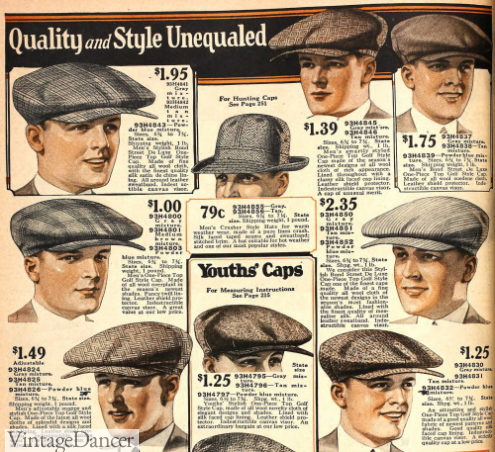
1927 men’s caps
Summer straw hats were much lighter and cooler to wear in warm weather. The classic straw boater or skimmer hat with a wide solid or striped band was the most common summer hat. It had a flat oval top and stiff round brim. Similar oval crown hats were made of finer Panama straw or coarse coconut fiber with a slightly rolled brim.
The Optimo Panama hat was the finest of men’s straw hats. It had a rounded crease down the center crown and a wide brim. It could be rolled up and slid into a coat pocket. Other straw hats came in the Leghorn style, gambler, western Carlsbad, and fedora.
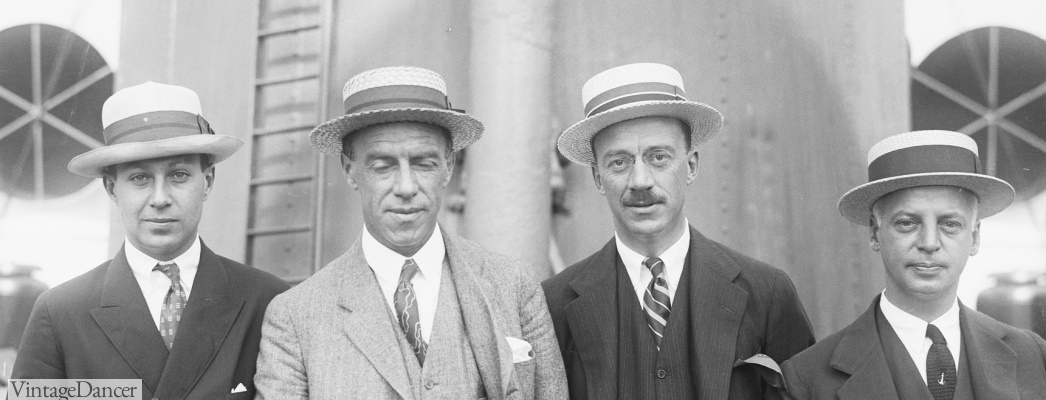
1923 men wearing straw hats- optimo panama hat and boaters
Felt hats were worn all year in neutral colors: navy blue, grey, tan, brown, green, and black. The round top black, brown, or grey Derby hat (bowler) continued to be worn by British businessmen, but was hardly seen in America. The stiff black, brown, or grey homburg was the American choice for business dress. The brim was narrow with a curled edge, and the crown had a deep center dent.
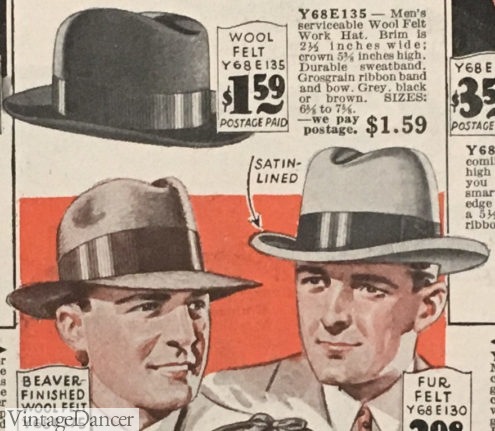
1929 felt hats – homburgs and snap-brim fedora
The fedora hat is the most iconic hat of the decade. It was considered a stylish young man’s hat with a wide brim, tall crown, and center dent or pinch front. The brim was snapped down slightly in front and up in the back, although the shape was entirely up to the wearer. Fedora hats and other felt hats hardly ever matched suit colors.
A grey suit paired well with a blue hat. A brown suit looked good with a grey hat. A blue suit also looked dapper with a grey or light tan hat. Black hats paired well with every suit color except light summer suiting. Hat bands were usually a shade darker than the body, with a wide flat bow on one side (no feathers yet).
Read more about 1920s men’s hat styles here.
Hat Tips: Vintage fedora hats had wide brims, not the skinny brims sold with modern fedoras. Golf caps were also wide and floppy, not narrow and fitted. Choose the nicest quality hat you can afford in a wide width and be prepared for waves of compliments. Especially from the ladies. You will stand out even more if your hat is anything but black.
- Suits: Choose a derby, homburg or wide brim fedora in a color opposite of your suit
- Casual: Choose a newsboy cap (not matching clothing color) or straw boater
- Summer: A light straw Panama or straw fedora or light colored felt hat will keep you cool
- Buy men’s 1920s style hats here
Keeping a hat all season without losing it or having it smashed in public places became a daily chore. Learn more about the social history of men’s 1920s hats and hat wearing etiquette here.
1920s Men’s Shoes
The turn of the century had most men wearing lace-up dress boots, but by the 1920s, the preferred shoe was the Oxford. The 1920s Oxford was a short lace up in black, dark brown, rust-brown, or white with a cap toe. The wingtip toe was also found on a few fancy models of boots and Oxfords. The two-tone “Art Deco” Oxford in either brown and ivory leather or brown leather and white canvas was becoming trendy on the golf course and for leisurely days, however it wouldn’t go mainstream until the 1930s.
- 1927 blucher toe men’s oxfords
- 1922 almond toe oxford shoes and boots
- 1925 mens work boots and sport sneakers
- 1927 two tone sport oxford
The shape of men’s shoes started off with a pointy almond toe that turned into the square toe style, mimicking the change from slim suits to wide suits. Leather soles were the same color as the shoe body with the exception of sports shoes, which may have had rubber crepe soles. In the later years, alligator, snake, and lizard skin were used to add texture to Oxfords. Perforations, pinking, and broguing along with the toe caps also added interesting details.
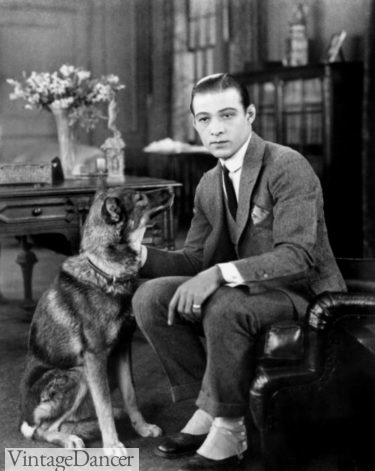
Rudolph Valentino wears white spats over his boots
The most casual sports shoe was the canvas high top sneaker (Converse) or low top flats (Keds, Plimsoles) in all white or white with brown leather trim. Soles were rubber and flexible. Each sport had its own version of sports shoe to accommodate indoor and outdoor games.
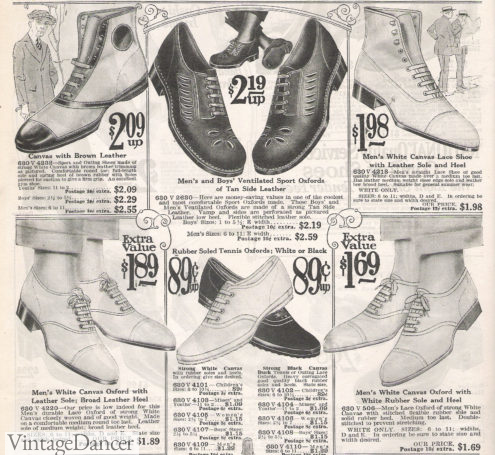
1922 mens canvas sport shoes
Working class men wore sturdy lace-up boots made of thick horsehide leather. Older gentlemen and the wealthy also continued to wear dress boots, as well as grey or tan wool spats that protected boots and shoes from dirt and grime. White spats were only practical to wear for special occasions.
Read more about 1920s men’s shoes style here.
Men’s pants hung down to the top of the shoe to prevent the crease from buckling. This exposed the socks, which were worn high up the leg calf and secured with sock garters. Socks were usually plain, striped or argyle patterns in fun colors. Buy 1920s Style Men’s Socks
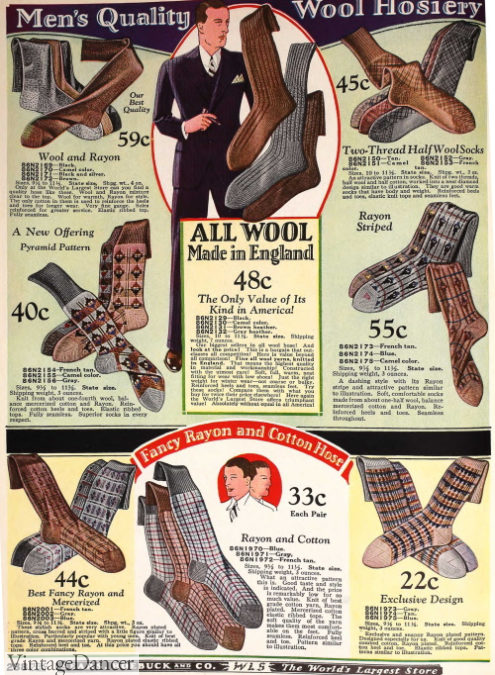
1928 men’s socks- dressy and casual
1920s Neck Ties and Bow Ties

The other fun bit of color in a 1920s men’s outfit was the neckwear. Men either wore a bow tie in wide stripes or polka dots, a striped or plaid necktie or a neck scarf tie.
Bow ties were the self-tying variety and usually had a thick or puffy butterfly shape.
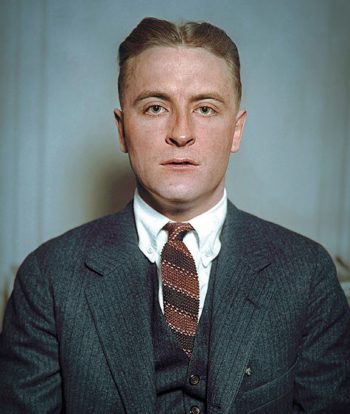
F Scott Fitzgerald wears a knit skinny tie
Neckties had diagonal stripes, plaid, check, paisley, or an Art Deco inspired pattern. Solid bright colors made of wool or silk were also common such as yellow, orange, red, or green (think 1970s colors). They were narrow and short (a few inches above the pants, which were already high up). Thin knit stripe ties were another option with square or fringed tips.
Read more about the history of men’s ties and bowties or buy for vintage and new 1920s style ties.
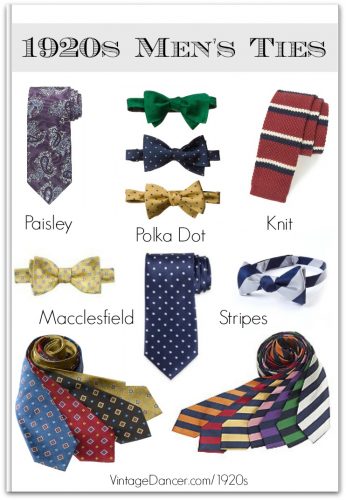
Classic 1920s men’s neckties and bow ties. Buy now.
1920s Men’s Accessories
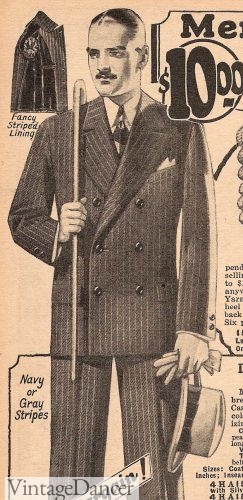
1927 man with glove, hat, pocket square and cane
The two other items of color in an older, wealthy gentleman’s wardrobe were gloves and pocket squares. Bright colors such as yellow or red gloves were a favorite choice over the traditional black, brown, or gray gloves. They were made of thin leather and buttoned at the wrist, sometimes with scalloped edges, but usually cut straight. These are the modern equivalent of unlined driving gloves and are usually hard to find in bright colors today.
The pocket square is a decoration-only handkerchief made of silk, folded into a triangle, and placed in the suit’s chest pocket. It coordinated with one color in a man’s tie or the band of his hat. A white cotton handkerchief was kept in the pants pocket for practical necessities.
What accessories were popular in the 1920s for men?
- Suspenders – Striped elastic suspenders or leather work suspender kept pants held up. A thin leather belt was also an option for casual outfits.
- Collar pin – Kept soft shirt collars down and neat. Cufflinks were also necessary to close french cuffs.
- Shoe Spats – White, grey or tan wool shoe covers for upper-class gentlemen
- Cane or walking stick – A gentleman’s walking accessory in the shepherd’s crook handle or silver-capped stick designs.
- Pocket watch and watch chain – The wristwatch was just coming into fashion. A pocket watch on a chain was slipped into the vest pocket and the chain hooked to one buttonhole.
- Arm Bands – Also were worn by most men, but are iconic for bartenders, bankers, and musicians to keep shirt sleeves out of the way.
- Glasses or sunglasses – round metal or tortoiseshell frame glasses
- Scarf – A paisley, striped or white silk men’s scarf was a new accessory in the late 1920s. Knit scarves for winter warmth
- Bag – A leather messenger style bag with short handles helped men carry papers to work or school
- Tall Socks – Argyle, Fair Isle, stripe, or solid dark color socks held up with elastic sock garters above the calf
- Smoking pipe, cigar or fake e-cigs (that puff water, like a vape)
Shop 1920’s men’s accessories here.
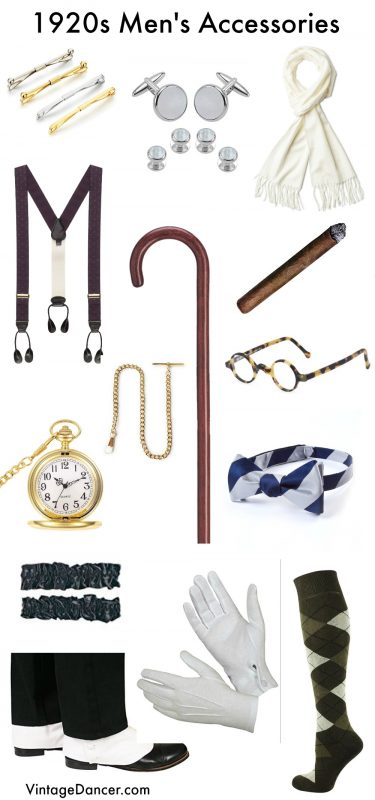
1920s men’s accessories: collar pin, cufflinks, cane, cigar, scarf, pocket watch and chain, bow tie, arm garters, gloves, socks, shoe spats
Men’s 1920s Outfit Ideas
What should a man wear to a 1920s party? You can easily make a men’s 1920s outfit from vintage-inspired modern clothes. Mixing suits, white collar shirts and wide leg pants, vests and suspenders, bow ties and hats will give you many roaring twenties outfits to try.
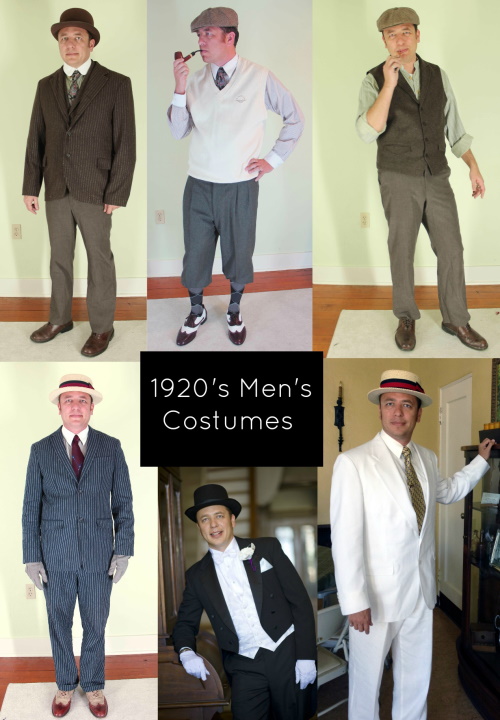
More 1920s men’s costume ideas… Click to learn.
- Learn how to create 10 different 1920s men’s outfit
- 1920s Men’s Outfit Inspiration & Costume Ideas Roaring Twenties
- Accurate 1920s Classic Car Show Costumes
- 1920s Casual Men’s Outfits– From suit to workwear, very trendy now
- Dress like Peaky Blinders
- Dress like the Great Gatsby (2013 movie) or his white suit
- Dress like Al Capone, 20s Gangster or other Boardwalk Empire Men
- Men’s vintage workwear – overalls, work clothes, boots
- Banker, Barbershop singer/musician, or Bartender outfits
- Casual men’s vintage outfits from the 1920s to the 50s
- Swimwear – History of women’s and men’s swimsuits
- 1920s Grooms and Groomsmen Attire – Men’s wedding attire and formalwear
- 1920s men’s costumes – Cheap Halloween, fancy dress or party costumes for gangsters, musicians, Gatsby, bootleggers, ect
- 1920s, 1930s, 1940s, 1950s Men’s Western Wear
- Vintage Big and Tall Men’s Clothing History
- 1920s Men’s Hairstyles and Products History
Shop 1920s Men’s Fashion Clothing
Featuring the most popular 20s clothes you can find online.
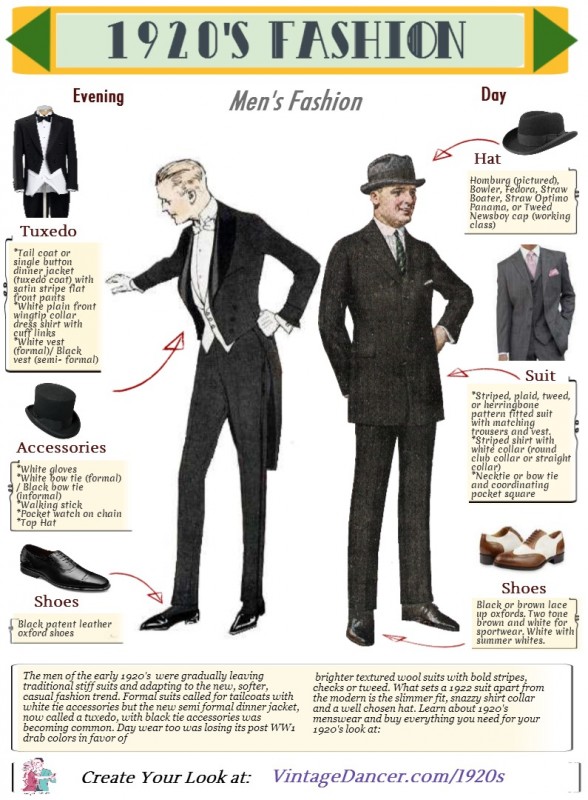
1920s men’s fashion guide for day and evening
Debbie Sessions has been teaching fashion history and helping people dress for vintage themed events since 2009. She has turned a hobby into VintageDancer.com with hundreds of well researched articles and hand picked links to vintage inspired clothing online. She aims to make dressing accurately (or not) an affordable option for all. Oh, and she dances too.
